Managing Recruitment, Selection and Induction Processes
VerifiedAdded on 2023/05/30
|8
|1492
|263
AI Summary
This text discusses the guidelines for hiring new employees, including knowing the law, identifying the role to be filled, finding and choosing the right people, offering employment, induction, and creating a productive environment. It also includes notes on the performance of an interviewee for a human resource manager position. Additionally, the text covers managing programs to promote personal effectiveness, including how to pursue senior management to approve the program, planning involved in setting up the program, and how to monitor and evaluate its effectiveness.
Contribute Materials
Your contribution can guide someone’s learning journey. Share your
documents today.
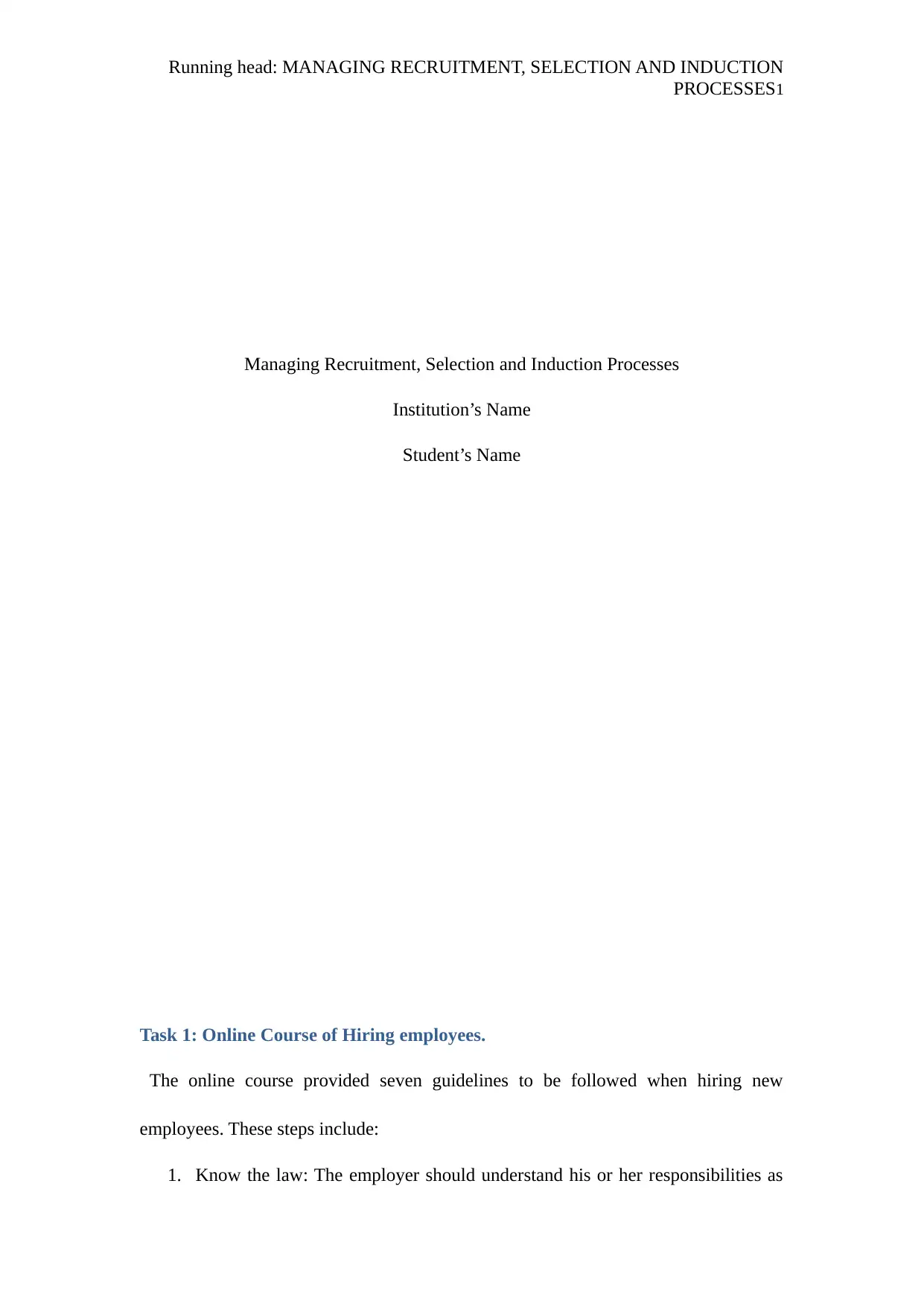
Running head: MANAGING RECRUITMENT, SELECTION AND INDUCTION
PROCESSES1
Managing Recruitment, Selection and Induction Processes
Institution’s Name
Student’s Name
Task 1: Online Course of Hiring employees.
The online course provided seven guidelines to be followed when hiring new
employees. These steps include:
1. Know the law: The employer should understand his or her responsibilities as
PROCESSES1
Managing Recruitment, Selection and Induction Processes
Institution’s Name
Student’s Name
Task 1: Online Course of Hiring employees.
The online course provided seven guidelines to be followed when hiring new
employees. These steps include:
1. Know the law: The employer should understand his or her responsibilities as
Secure Best Marks with AI Grader
Need help grading? Try our AI Grader for instant feedback on your assignments.
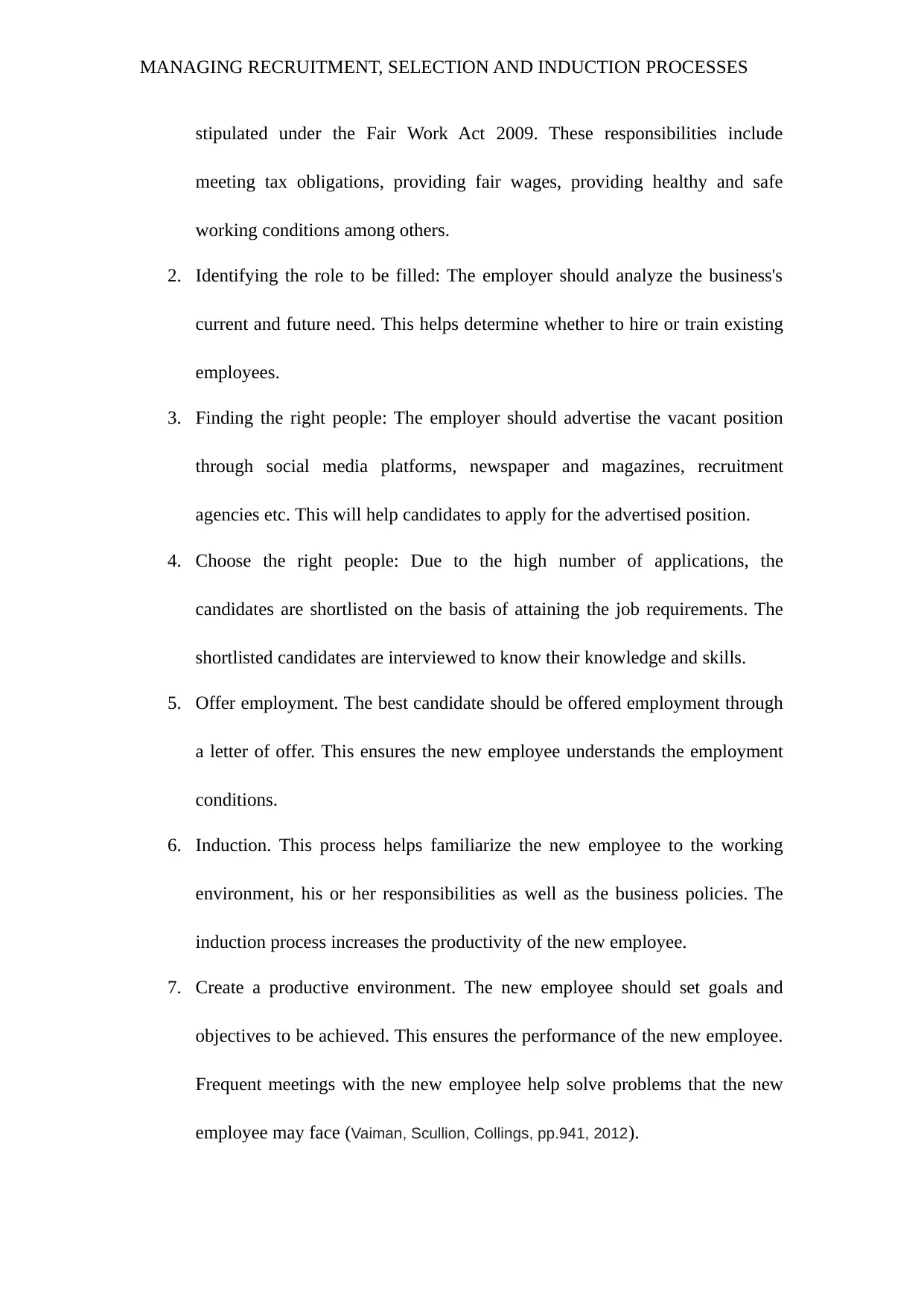
MANAGING RECRUITMENT, SELECTION AND INDUCTION PROCESSES
stipulated under the Fair Work Act 2009. These responsibilities include
meeting tax obligations, providing fair wages, providing healthy and safe
working conditions among others.
2. Identifying the role to be filled: The employer should analyze the business's
current and future need. This helps determine whether to hire or train existing
employees.
3. Finding the right people: The employer should advertise the vacant position
through social media platforms, newspaper and magazines, recruitment
agencies etc. This will help candidates to apply for the advertised position.
4. Choose the right people: Due to the high number of applications, the
candidates are shortlisted on the basis of attaining the job requirements. The
shortlisted candidates are interviewed to know their knowledge and skills.
5. Offer employment. The best candidate should be offered employment through
a letter of offer. This ensures the new employee understands the employment
conditions.
6. Induction. This process helps familiarize the new employee to the working
environment, his or her responsibilities as well as the business policies. The
induction process increases the productivity of the new employee.
7. Create a productive environment. The new employee should set goals and
objectives to be achieved. This ensures the performance of the new employee.
Frequent meetings with the new employee help solve problems that the new
employee may face (Vaiman, Scullion, Collings, pp.941, 2012).
stipulated under the Fair Work Act 2009. These responsibilities include
meeting tax obligations, providing fair wages, providing healthy and safe
working conditions among others.
2. Identifying the role to be filled: The employer should analyze the business's
current and future need. This helps determine whether to hire or train existing
employees.
3. Finding the right people: The employer should advertise the vacant position
through social media platforms, newspaper and magazines, recruitment
agencies etc. This will help candidates to apply for the advertised position.
4. Choose the right people: Due to the high number of applications, the
candidates are shortlisted on the basis of attaining the job requirements. The
shortlisted candidates are interviewed to know their knowledge and skills.
5. Offer employment. The best candidate should be offered employment through
a letter of offer. This ensures the new employee understands the employment
conditions.
6. Induction. This process helps familiarize the new employee to the working
environment, his or her responsibilities as well as the business policies. The
induction process increases the productivity of the new employee.
7. Create a productive environment. The new employee should set goals and
objectives to be achieved. This ensures the performance of the new employee.
Frequent meetings with the new employee help solve problems that the new
employee may face (Vaiman, Scullion, Collings, pp.941, 2012).
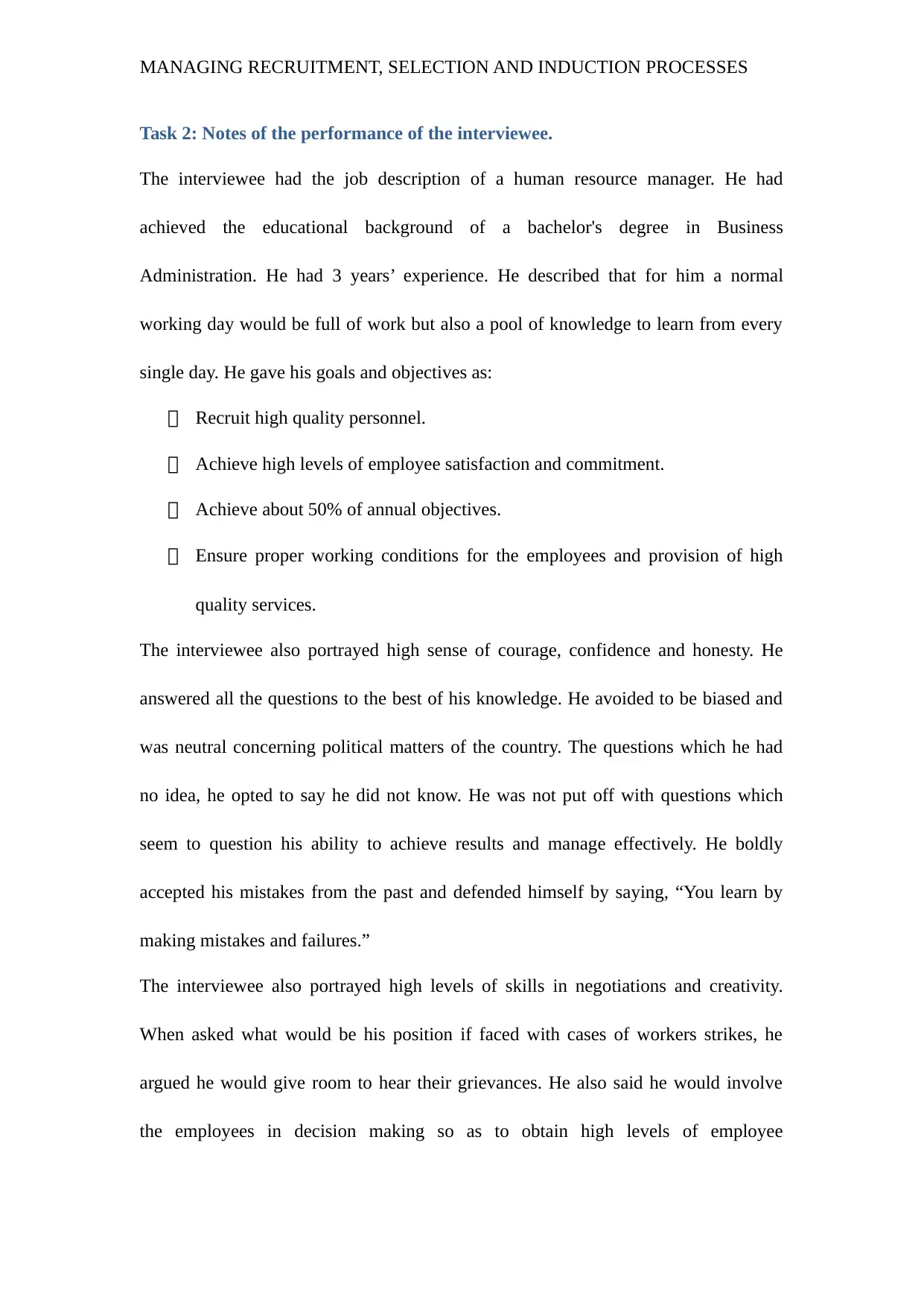
MANAGING RECRUITMENT, SELECTION AND INDUCTION PROCESSES
Task 2: Notes of the performance of the interviewee.
The interviewee had the job description of a human resource manager. He had
achieved the educational background of a bachelor's degree in Business
Administration. He had 3 years’ experience. He described that for him a normal
working day would be full of work but also a pool of knowledge to learn from every
single day. He gave his goals and objectives as:
Recruit high quality personnel.
Achieve high levels of employee satisfaction and commitment.
Achieve about 50% of annual objectives.
Ensure proper working conditions for the employees and provision of high
quality services.
The interviewee also portrayed high sense of courage, confidence and honesty. He
answered all the questions to the best of his knowledge. He avoided to be biased and
was neutral concerning political matters of the country. The questions which he had
no idea, he opted to say he did not know. He was not put off with questions which
seem to question his ability to achieve results and manage effectively. He boldly
accepted his mistakes from the past and defended himself by saying, “You learn by
making mistakes and failures.”
The interviewee also portrayed high levels of skills in negotiations and creativity.
When asked what would be his position if faced with cases of workers strikes, he
argued he would give room to hear their grievances. He also said he would involve
the employees in decision making so as to obtain high levels of employee
Task 2: Notes of the performance of the interviewee.
The interviewee had the job description of a human resource manager. He had
achieved the educational background of a bachelor's degree in Business
Administration. He had 3 years’ experience. He described that for him a normal
working day would be full of work but also a pool of knowledge to learn from every
single day. He gave his goals and objectives as:
Recruit high quality personnel.
Achieve high levels of employee satisfaction and commitment.
Achieve about 50% of annual objectives.
Ensure proper working conditions for the employees and provision of high
quality services.
The interviewee also portrayed high sense of courage, confidence and honesty. He
answered all the questions to the best of his knowledge. He avoided to be biased and
was neutral concerning political matters of the country. The questions which he had
no idea, he opted to say he did not know. He was not put off with questions which
seem to question his ability to achieve results and manage effectively. He boldly
accepted his mistakes from the past and defended himself by saying, “You learn by
making mistakes and failures.”
The interviewee also portrayed high levels of skills in negotiations and creativity.
When asked what would be his position if faced with cases of workers strikes, he
argued he would give room to hear their grievances. He also said he would involve
the employees in decision making so as to obtain high levels of employee
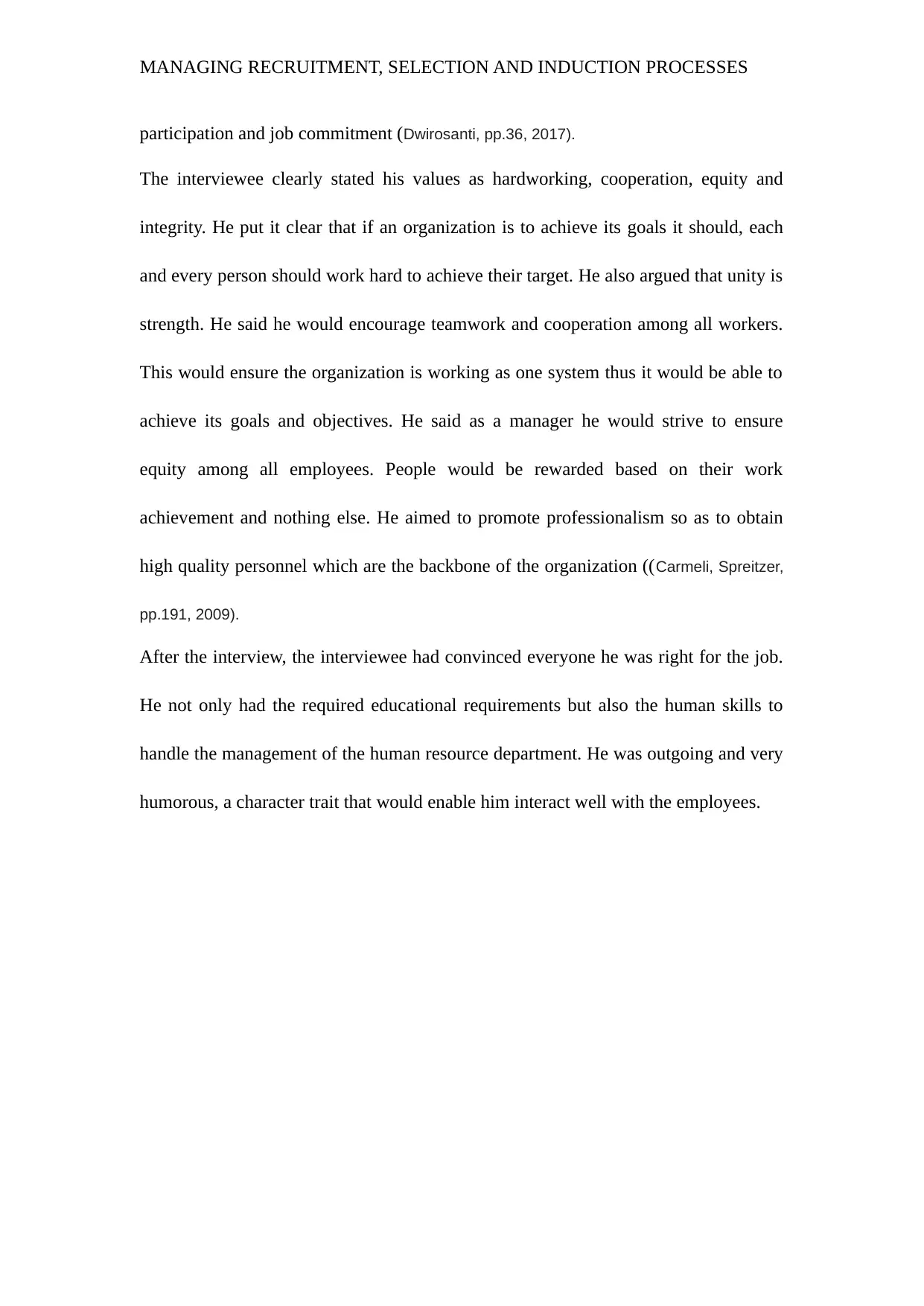
MANAGING RECRUITMENT, SELECTION AND INDUCTION PROCESSES
participation and job commitment (Dwirosanti, pp.36, 2017).
The interviewee clearly stated his values as hardworking, cooperation, equity and
integrity. He put it clear that if an organization is to achieve its goals it should, each
and every person should work hard to achieve their target. He also argued that unity is
strength. He said he would encourage teamwork and cooperation among all workers.
This would ensure the organization is working as one system thus it would be able to
achieve its goals and objectives. He said as a manager he would strive to ensure
equity among all employees. People would be rewarded based on their work
achievement and nothing else. He aimed to promote professionalism so as to obtain
high quality personnel which are the backbone of the organization ((Carmeli, Spreitzer,
pp.191, 2009).
After the interview, the interviewee had convinced everyone he was right for the job.
He not only had the required educational requirements but also the human skills to
handle the management of the human resource department. He was outgoing and very
humorous, a character trait that would enable him interact well with the employees.
participation and job commitment (Dwirosanti, pp.36, 2017).
The interviewee clearly stated his values as hardworking, cooperation, equity and
integrity. He put it clear that if an organization is to achieve its goals it should, each
and every person should work hard to achieve their target. He also argued that unity is
strength. He said he would encourage teamwork and cooperation among all workers.
This would ensure the organization is working as one system thus it would be able to
achieve its goals and objectives. He said as a manager he would strive to ensure
equity among all employees. People would be rewarded based on their work
achievement and nothing else. He aimed to promote professionalism so as to obtain
high quality personnel which are the backbone of the organization ((Carmeli, Spreitzer,
pp.191, 2009).
After the interview, the interviewee had convinced everyone he was right for the job.
He not only had the required educational requirements but also the human skills to
handle the management of the human resource department. He was outgoing and very
humorous, a character trait that would enable him interact well with the employees.
Secure Best Marks with AI Grader
Need help grading? Try our AI Grader for instant feedback on your assignments.
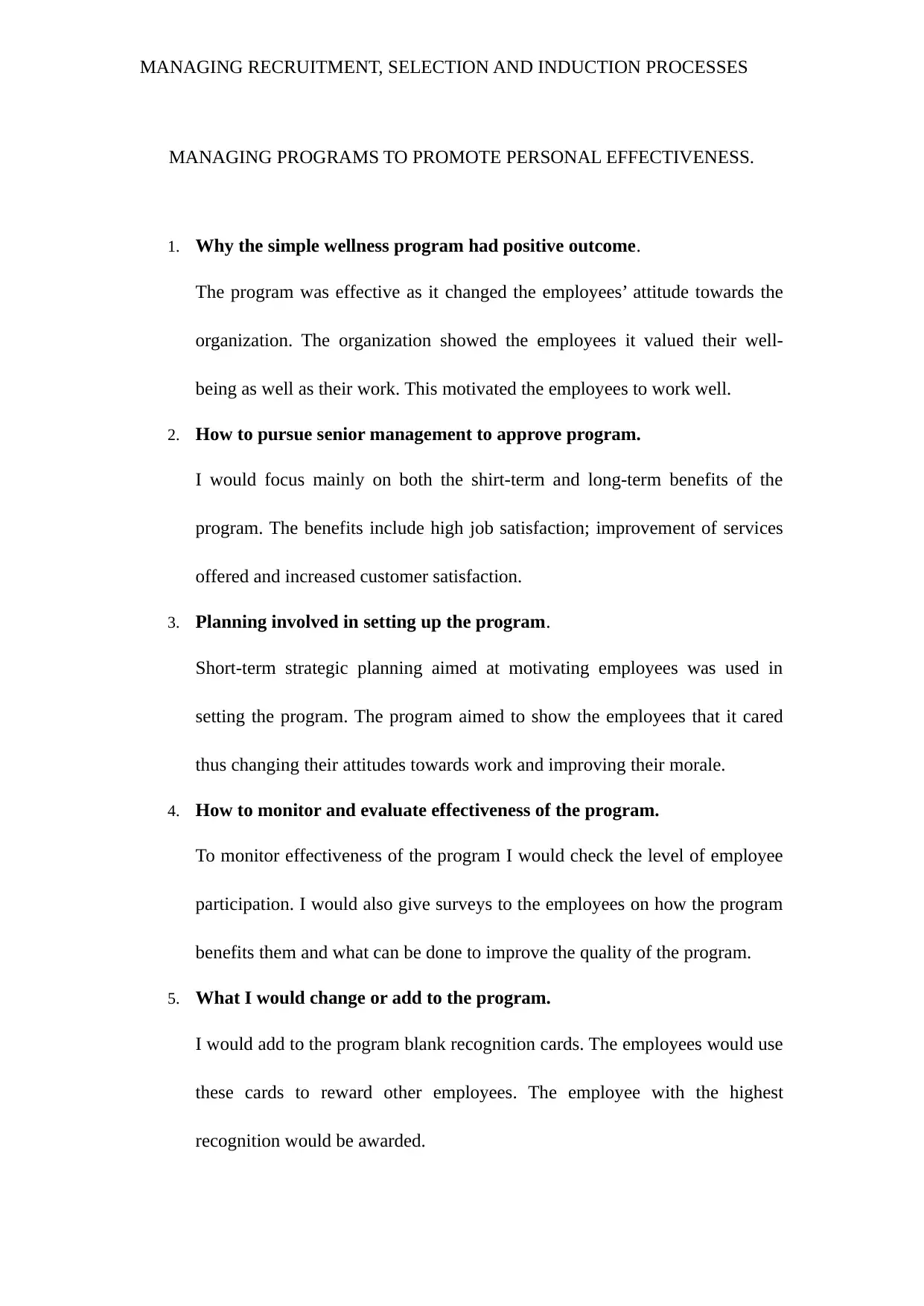
MANAGING RECRUITMENT, SELECTION AND INDUCTION PROCESSES
MANAGING PROGRAMS TO PROMOTE PERSONAL EFFECTIVENESS.
1. Why the simple wellness program had positive outcome.
The program was effective as it changed the employees’ attitude towards the
organization. The organization showed the employees it valued their well-
being as well as their work. This motivated the employees to work well.
2. How to pursue senior management to approve program.
I would focus mainly on both the shirt-term and long-term benefits of the
program. The benefits include high job satisfaction; improvement of services
offered and increased customer satisfaction.
3. Planning involved in setting up the program.
Short-term strategic planning aimed at motivating employees was used in
setting the program. The program aimed to show the employees that it cared
thus changing their attitudes towards work and improving their morale.
4. How to monitor and evaluate effectiveness of the program.
To monitor effectiveness of the program I would check the level of employee
participation. I would also give surveys to the employees on how the program
benefits them and what can be done to improve the quality of the program.
5. What I would change or add to the program.
I would add to the program blank recognition cards. The employees would use
these cards to reward other employees. The employee with the highest
recognition would be awarded.
MANAGING PROGRAMS TO PROMOTE PERSONAL EFFECTIVENESS.
1. Why the simple wellness program had positive outcome.
The program was effective as it changed the employees’ attitude towards the
organization. The organization showed the employees it valued their well-
being as well as their work. This motivated the employees to work well.
2. How to pursue senior management to approve program.
I would focus mainly on both the shirt-term and long-term benefits of the
program. The benefits include high job satisfaction; improvement of services
offered and increased customer satisfaction.
3. Planning involved in setting up the program.
Short-term strategic planning aimed at motivating employees was used in
setting the program. The program aimed to show the employees that it cared
thus changing their attitudes towards work and improving their morale.
4. How to monitor and evaluate effectiveness of the program.
To monitor effectiveness of the program I would check the level of employee
participation. I would also give surveys to the employees on how the program
benefits them and what can be done to improve the quality of the program.
5. What I would change or add to the program.
I would add to the program blank recognition cards. The employees would use
these cards to reward other employees. The employee with the highest
recognition would be awarded.
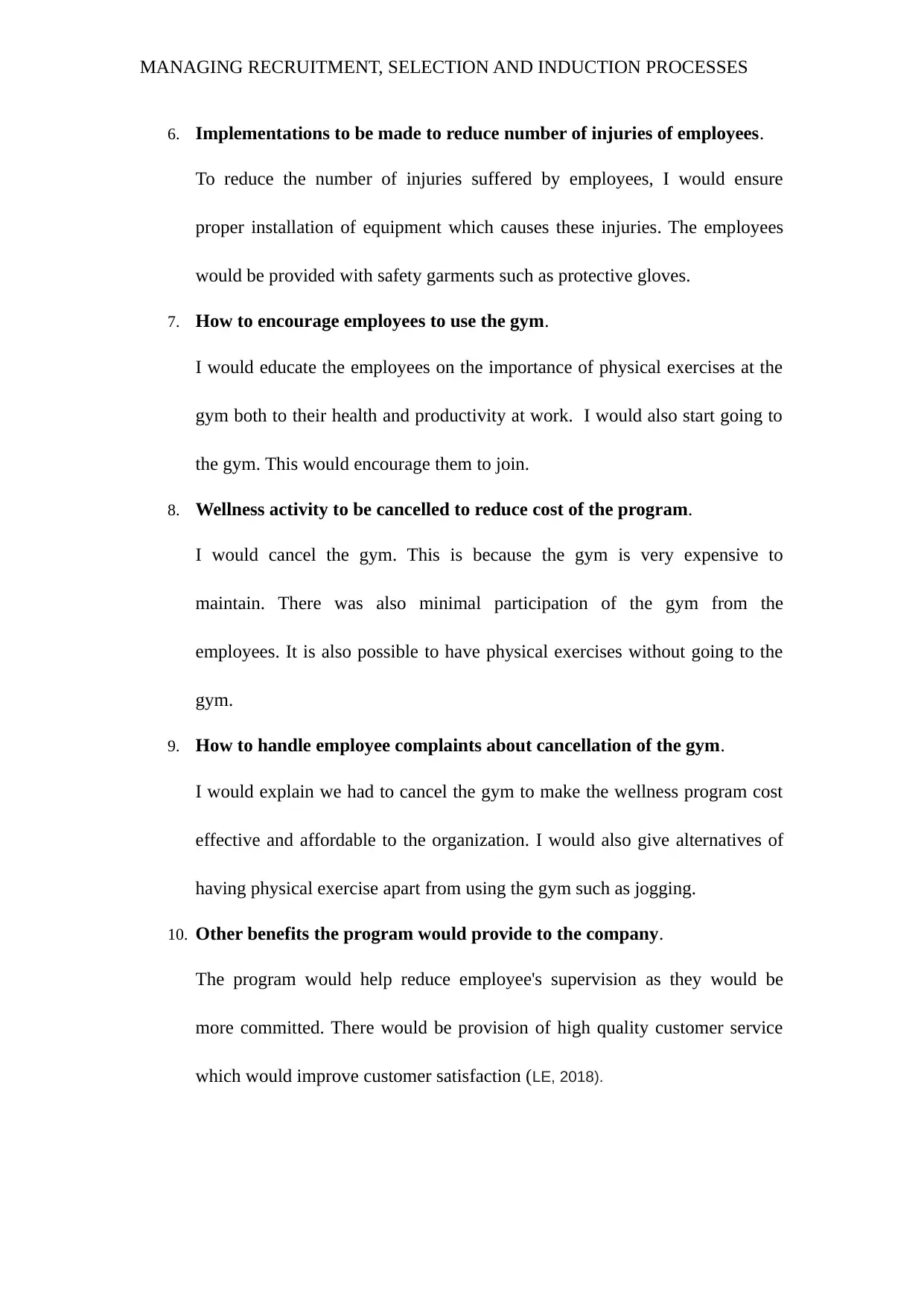
MANAGING RECRUITMENT, SELECTION AND INDUCTION PROCESSES
6. Implementations to be made to reduce number of injuries of employees.
To reduce the number of injuries suffered by employees, I would ensure
proper installation of equipment which causes these injuries. The employees
would be provided with safety garments such as protective gloves.
7. How to encourage employees to use the gym.
I would educate the employees on the importance of physical exercises at the
gym both to their health and productivity at work. I would also start going to
the gym. This would encourage them to join.
8. Wellness activity to be cancelled to reduce cost of the program.
I would cancel the gym. This is because the gym is very expensive to
maintain. There was also minimal participation of the gym from the
employees. It is also possible to have physical exercises without going to the
gym.
9. How to handle employee complaints about cancellation of the gym.
I would explain we had to cancel the gym to make the wellness program cost
effective and affordable to the organization. I would also give alternatives of
having physical exercise apart from using the gym such as jogging.
10. Other benefits the program would provide to the company.
The program would help reduce employee's supervision as they would be
more committed. There would be provision of high quality customer service
which would improve customer satisfaction (LE, 2018).
6. Implementations to be made to reduce number of injuries of employees.
To reduce the number of injuries suffered by employees, I would ensure
proper installation of equipment which causes these injuries. The employees
would be provided with safety garments such as protective gloves.
7. How to encourage employees to use the gym.
I would educate the employees on the importance of physical exercises at the
gym both to their health and productivity at work. I would also start going to
the gym. This would encourage them to join.
8. Wellness activity to be cancelled to reduce cost of the program.
I would cancel the gym. This is because the gym is very expensive to
maintain. There was also minimal participation of the gym from the
employees. It is also possible to have physical exercises without going to the
gym.
9. How to handle employee complaints about cancellation of the gym.
I would explain we had to cancel the gym to make the wellness program cost
effective and affordable to the organization. I would also give alternatives of
having physical exercise apart from using the gym such as jogging.
10. Other benefits the program would provide to the company.
The program would help reduce employee's supervision as they would be
more committed. There would be provision of high quality customer service
which would improve customer satisfaction (LE, 2018).
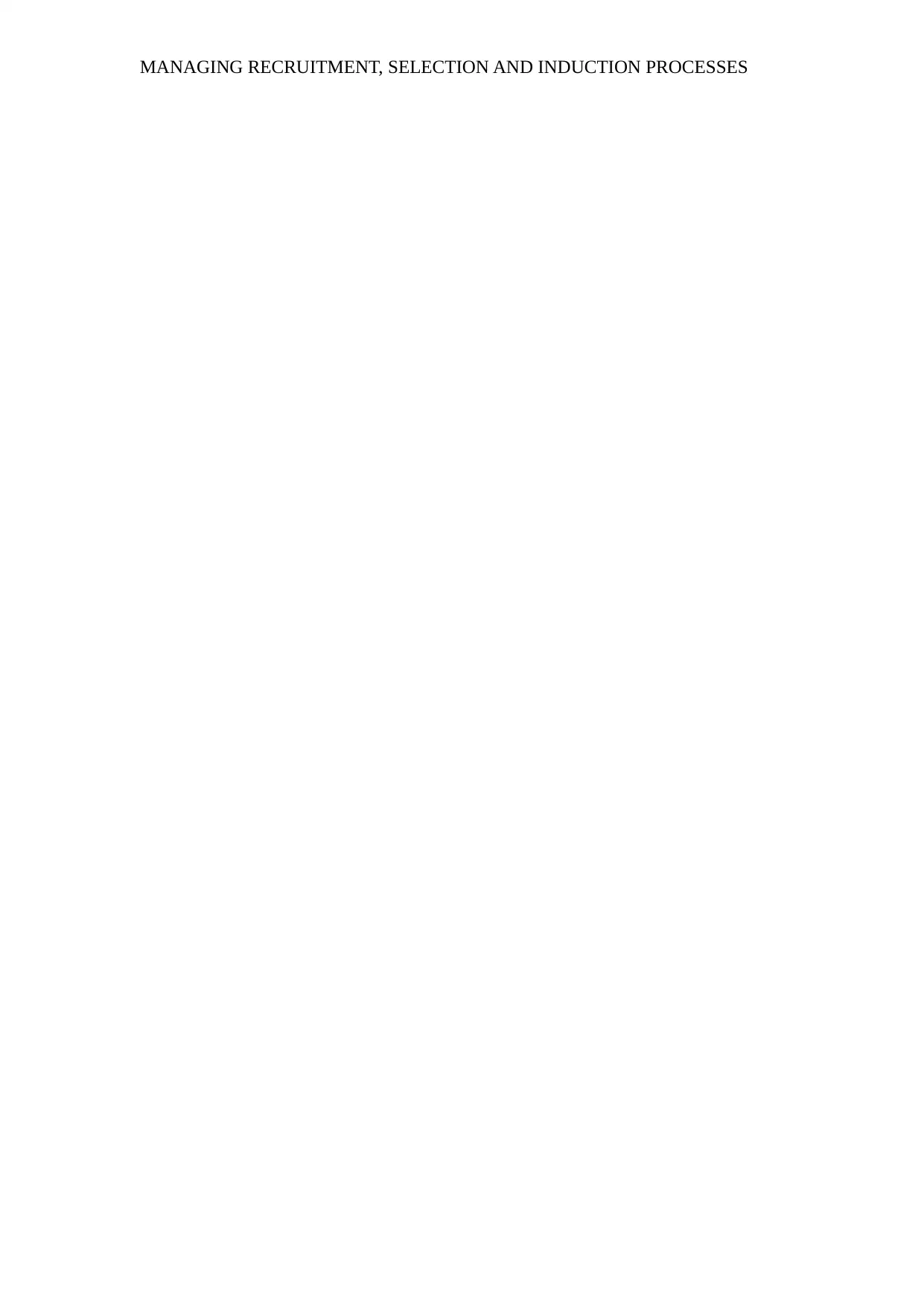
MANAGING RECRUITMENT, SELECTION AND INDUCTION PROCESSES
Paraphrase This Document
Need a fresh take? Get an instant paraphrase of this document with our AI Paraphraser
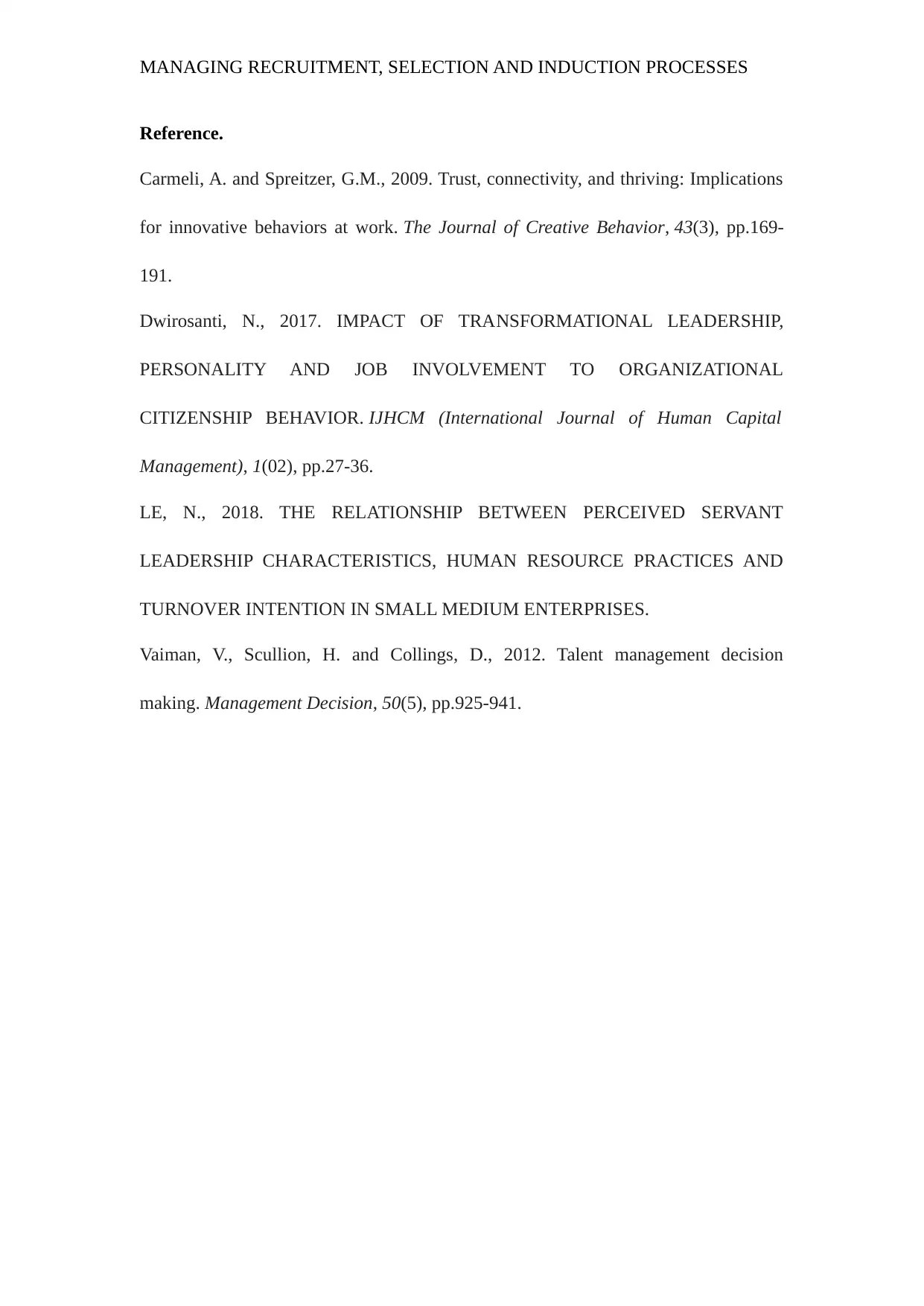
MANAGING RECRUITMENT, SELECTION AND INDUCTION PROCESSES
Reference.
Carmeli, A. and Spreitzer, G.M., 2009. Trust, connectivity, and thriving: Implications
for innovative behaviors at work. The Journal of Creative Behavior, 43(3), pp.169-
191.
Dwirosanti, N., 2017. IMPACT OF TRANSFORMATIONAL LEADERSHIP,
PERSONALITY AND JOB INVOLVEMENT TO ORGANIZATIONAL
CITIZENSHIP BEHAVIOR. IJHCM (International Journal of Human Capital
Management), 1(02), pp.27-36.
LE, N., 2018. THE RELATIONSHIP BETWEEN PERCEIVED SERVANT
LEADERSHIP CHARACTERISTICS, HUMAN RESOURCE PRACTICES AND
TURNOVER INTENTION IN SMALL MEDIUM ENTERPRISES.
Vaiman, V., Scullion, H. and Collings, D., 2012. Talent management decision
making. Management Decision, 50(5), pp.925-941.
Reference.
Carmeli, A. and Spreitzer, G.M., 2009. Trust, connectivity, and thriving: Implications
for innovative behaviors at work. The Journal of Creative Behavior, 43(3), pp.169-
191.
Dwirosanti, N., 2017. IMPACT OF TRANSFORMATIONAL LEADERSHIP,
PERSONALITY AND JOB INVOLVEMENT TO ORGANIZATIONAL
CITIZENSHIP BEHAVIOR. IJHCM (International Journal of Human Capital
Management), 1(02), pp.27-36.
LE, N., 2018. THE RELATIONSHIP BETWEEN PERCEIVED SERVANT
LEADERSHIP CHARACTERISTICS, HUMAN RESOURCE PRACTICES AND
TURNOVER INTENTION IN SMALL MEDIUM ENTERPRISES.
Vaiman, V., Scullion, H. and Collings, D., 2012. Talent management decision
making. Management Decision, 50(5), pp.925-941.
1 out of 8
Related Documents
Your All-in-One AI-Powered Toolkit for Academic Success.
+13062052269
info@desklib.com
Available 24*7 on WhatsApp / Email
![[object Object]](/_next/static/media/star-bottom.7253800d.svg)
Unlock your academic potential
© 2024 | Zucol Services PVT LTD | All rights reserved.



